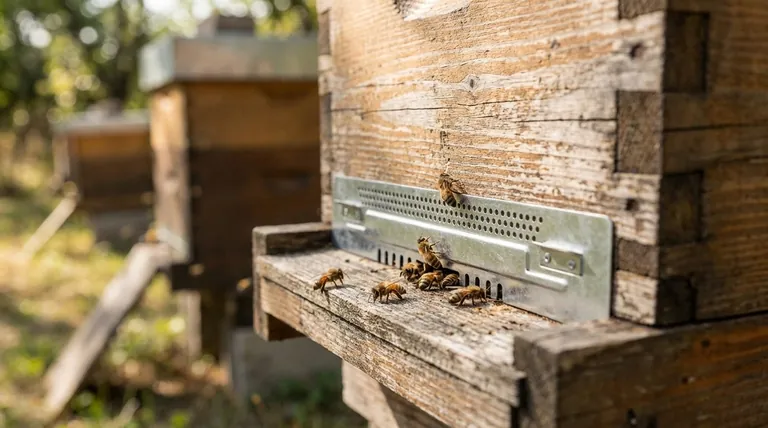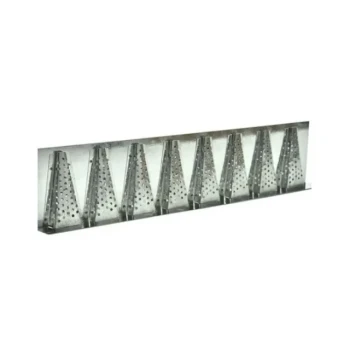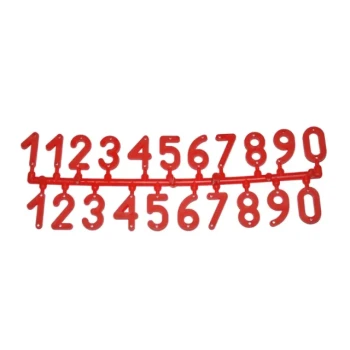In short, an entrance reducer is a simple but critical tool for managing the size of a beehive's main entrance. Its primary purpose is to make the entrance smaller, which helps the colony defend itself from intruders, block pests like mice, and better control its internal temperature, especially during vulnerable periods.
A hive's large, open entrance can be a significant liability. The entrance reducer functions like a gatekeeper, scaling the size of the "front door" to match the colony's current ability to defend it, thereby increasing its security and chances of survival.

The Core Functions of an Entrance Reducer
A reducer is typically a small, rectangular piece of wood with different-sized notches cut into it, allowing you to select how large or small the entrance will be. While simple, it serves several distinct and vital functions throughout the beekeeping year.
Aiding in Hive Defense
A colony's strength is its numbers. Guard bees patrol the entrance to repel intruders, such as wasps, hornets, or bees from other hives attempting to steal honey (a behavior known as "robbing").
A wide-open entrance is a massive front line for a small force of guard bees to defend. By reducing the entrance size, you create a chokepoint that a few guards can effectively patrol, preventing them from being overwhelmed.
Supporting New or Weak Colonies
When you install a new package of bees or a small nucleus colony, their population is low. They have very few foragers and even fewer guard bees.
Using an entrance reducer on its smallest setting gives this burgeoning colony a defensible space. It allows them to focus their energy on building comb and raising brood without the constant threat of being raided and destroyed by stronger, nearby hives.
Winter Pest Control
As temperatures drop, mice and other rodents seek warm, sheltered places to spend the winter. A beehive, with its stored honey and clustered warmth, is an ideal target.
An entrance reducer, especially when set to its smallest opening, physically blocks mice from entering the hive. This is critical because a wintering bee cluster is often too cold and slow to mount an effective defense against a warm-blooded predator.
Managing Airflow and Temperature
In the winter, bees form a tight cluster to generate and conserve heat. A large, open entrance creates a significant draft and allows precious warmth to escape, forcing the bees to consume more of their honey stores to stay warm.
By reducing the entrance, you minimize this heat loss. While some ventilation is still necessary, a smaller opening helps the colony maintain its core temperature more efficiently, improving its chances of surviving a long winter.
Understanding the Trade-offs and When to Remove It
An entrance reducer is a tool for specific situations, not a permanent fixture. Using it at the wrong time can hinder your colony's progress.
Limiting Foraging Traffic
During a strong nectar flow in spring and summer, a healthy, populous hive has thousands of bees coming and going. A small entrance creates a traffic jam.
This bottleneck reduces foraging efficiency, as bees waste time and energy waiting to get in or out. It can directly impact the amount of honey your colony is able to produce.
Restricting Ventilation in Summer
Bees work hard to cool the hive in hot weather by fanning their wings. A reducer severely restricts this critical airflow, which can lead to the hive overheating.
Overheating stresses the colony and can make it difficult for them to properly cure honey. If you see bees "bearding" (hanging in a large mass on the outside of the hive), it is often a sign they need more ventilation.
The Mouse Guard Limitation
While a wooden entrance reducer can block mice, a determined rodent can and will chew through the wood to gain access.
For definitive winter protection, many beekeepers prefer to use a dedicated metal mouse guard. These serve the same function but are impossible for rodents to chew through, offering more reliable security.
How to Apply This to Your Hive
Using an entrance reducer effectively means matching its use to the season and your colony's specific strength.
- If you are installing a new package or nuc: Use the smallest opening to give the small colony a secure, defensible starting point.
- If you are heading into fall and winter: Use a medium or small opening to prevent robbing as nectar becomes scarce and to block pests once the weather turns cold.
- If your hive is strong and it's peak nectar flow: Remove the reducer entirely to maximize foraging efficiency and provide ample ventilation.
- If your hive appears weak or is recovering from disease: Keep a reducer in place to help the diminished population defend itself until it regains strength.
Proper use of an entrance reducer is a hallmark of a beekeeper who understands and adapts to a colony's changing needs throughout the year.
Summary Table:
| Purpose | Key Benefit | Best Used When |
|---|---|---|
| Hive Defense | Creates a defensible chokepoint against robbers | Installing new packages, weak colonies |
| Pest Control | Blocks mice and other rodents from entering | Fall and winter seasons |
| Temperature Management | Reduces drafts and helps conserve hive warmth | Cold winter months |
| Traffic & Ventilation | Must be removed to prevent bottlenecks and overheating | Strong colonies during peak nectar flow |
Equip your apiary with the right tools for every season. HONESTBEE supplies durable, reliable beekeeping supplies and equipment to commercial apiaries and distributors through wholesale-focused operations. Ensure your colonies are protected and productive year-round. Contact our experts today to discuss your wholesale needs.
Visual Guide

Related Products
- Beehive Entrance Reducer Guardian Metal Hive Entrance for Bees
- Multi-Functional Sliding Hive Entrance for Beekeeping
- Steel Round Disc Entrance Reducer for Flexzion Bee Hive Nuc Box Gate
- Multi-Functional Rotary Hive Entrance Disc for Beekeeping
- Professional Reversible Beehive Hive Entrance
People Also Ask
- What should be done after transferring frames to the new hive? Essential Steps for a Secure Colony
- How can a Langstroth hive entrance be adjusted? Mimic Natural Bee Preferences for a Healthier Hive
- What happens if you seal an entrance to a bee hive? Avoid a Costly Structural Disaster
- What size is the entrance hole in a native bee hive? The 13mm Standard for a Thriving Colony
- How big should a beehive entrance be? Optimize for Colony Health & Honey Production



















